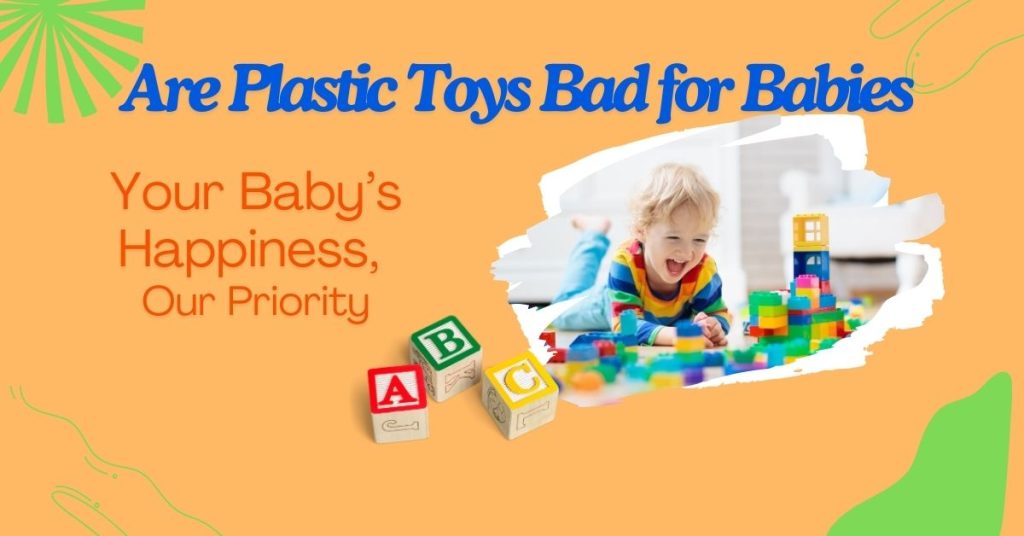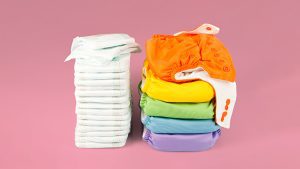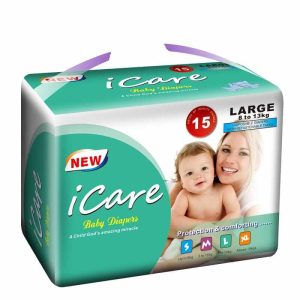Ensuring our little “Are Plastic Toys Bad for Babies?” one’s safety and well-being is a top priority. This concern extends to the toys they play with, as these objects are not only sources of entertainment but also tools for development. Parents and caregivers have increasingly raised a question: “Are plastic toys bad for babies?” This article delves deep into plastic toys’ potential risks and benefits, exploring safety standards and alternative materials and providing practical advice for parents.
The Ubiquity of Plastic Toys
Are Plastic Toys Bad for Babies? Review- Plastic toys are ubiquitous in households worldwide, primarily because they are affordable, durable, and versatile. They come in various shapes, sizes, and colors, often incorporating educational elements to help a child’s developmental process. However, the material that makes these toys appealing also brings potential risks.

Understanding Plastic and Its Components
Are Plastic Toys Bad for Babies? Review- Plastic is a synthetic material made from polymers, which can contain various additives to enhance durability, flexibility, color, and other properties.

The main concerns regarding plastic toys for babies arise from certain chemicals used in the manufacturing process:
- Bisphenol A (BPA): A chemical that produces polycarbonate plastics and epoxy resins. BPA can mimic estrogen, potentially disrupting the endocrine system.
- Phthalates: These make plastics more flexible. Some phthalates are suspected to interfere with hormone function.
- Lead and Heavy Metals: Sometimes found in paint and coatings, these metals can be toxic, particularly to young children whose bodies and brains are still developing.
Are plastic toys bad for babies’ teething
When it comes to teething, babies often seek comfort by chewing on anything they can get their hands on, making the safety of teething toys a paramount concern for parents. Plastic teething toys, widely available due to their affordability and variety, are scrutinized for potential health risks.

One primary concern is the presence of harmful chemicals like Bisphenol A (BPA) and phthalates, commonly used to enhance plastic’s durability and flexibility. These chemicals can leach out when the toy is chewed on, posing potential health risks such as hormonal disruptions and developmental issues. Moreover, plastic toys can sometimes contain small parts that might break off and present choking hazards. While regulations in many countries aim to limit the levels of these harmful substances, not all products meet these safety standards, especially those from unregulated markets.
Parents increasingly opt for teething toys made from food-grade silicone, natural rubber, and organic fabrics as a safer alternative. These materials are generally free from harmful chemicals and offer various textures that effectively soothe a baby’s gums. Additionally, wooden teething toys finished with non-toxic, water-based paints or oils are gaining popularity for their safety and environmental benefits. Thus, while plastic teething toys can be convenient, their potential risks to a baby’s health prompt many parents to consider safer, non-toxic alternatives to ensure their child’s safety during this crucial developmental stage. Know more to visit
Are plastic toys bad for babies? Potential Risks of Plastic Toys
- Chemical Exposure: Babies often put toys in their mouths, increasing the risk of ingesting harmful chemicals like BPA and phthalates. Chronic Exposure to these chemicals, even at low levels, can have long-term health implications.
- Choking Hazards: Many plastic toys contain small parts that can break off, posing a choking risk. This is particularly dangerous for babies under three years old.
- Environmental Impact: While not a direct health risk to babies, plastic toys have a significant environmental impact. They contribute to pollution and are often not biodegradable, raising concerns about the kind of world we are leaving for future generations.
Regulations and Safety Standards
To address these concerns, various regulations and safety standards have been put in place globally:
- United States: The Consumer Product Safety Improvement Act (CPSIA) regulates the levels of lead, phthalates, and other harmful substances in children’s products.
- European Union: The REACH regulation (Registration, Evaluation, Authorisation, and Restriction of Chemicals) and the Toy Safety Directive ensure stringent toy safety measures.
- International Standards: Organizations like ASTM International provide guidelines to ensure toy safety.
Parents must remain vigilant despite these regulations, as not all products, especially those from unregulated markets, are subject to rigorous testing.
Alternative Materials for Baby Toys
Given the potential risks associated with plastic toys, many parents are turning to alternative materials that are perceived to be safer and more environmentally friendly:
- Wooden Toys: Made from natural materials, wooden toys are durable and biodegradable. Ensure they are finished with non-toxic paints and sealants.
- Silicone Toys: High-quality food-grade silicone is a safe, non-toxic alternative to plastic, often used in teething toys.
- Fabric Toys: Made from organic cotton or other natural fibers, fabric toys are soft and safe for babies to chew on.
- Natural Rubber Toys: These are made from the sap of rubber trees and are free from harmful chemicals.
Benefits of Non-Plastic Toys
Switching to non-plastic toys can offer several benefits:
- Reduced Chemical Exposure: Minimizing contact with harmful chemicals like BPA and phthalates.
- Environmental Sustainability: Choosing biodegradable or recyclable materials helps reduce environmental impact.
- Sensory Development: Natural materials often have different textures and smells that stimulate a baby’s senses more effectively than plastic.
Practical Tips for Parents

- Research and Choose Wisely: Look for toys that meet safety standards and are free from harmful chemicals. Brands that are transparent about their materials and manufacturing processes are preferable.
- Inspect Toys Regularly: Check for signs of wear and tear and tiny parts that could become choking hazards.
- Limit Exposure: Avoid toys with electronic components that could emit electromagnetic fields (EMFs).
- Supervise Playtime: Always supervise babies while they play to prevent accidents.
- Clean Toys Regularly: Ensure toys are cleaned frequently, especially those babies put in their mouths.
Ask Mom Detective: Are Plastic Toys Safe for My Children?
Are Plastic Toys Bad for Babies? Review- Navigating the world of children’s toys can be daunting for any parent, particularly when it comes to ensuring the safety of plastic toys. In “Ask Mom Detective: Are Plastic Toys Safe for My Children?” a thoughtful investigation unravels the complexities surrounding this ubiquitous category of playthings. Plastic toys, cherished for their durability, vibrant colors, and affordability, often find their way into the hands of excited children. However, concerns regarding their safety have prompted many parents to don their detective hats, probing into the materials and chemicals used in toy manufacturing.
One of the primary concerns about plastic toys centers around harmful chemicals like phthalates, bisphenol A (BPA), and lead. Phthalates, often used to make plastics more flexible, have been linked to health issues such as hormonal disruptions and developmental problems. BPA, another chemical commonly found in plastics, has raised alarms due to its potential effects on brain development and behavior in children. Lead, while less widely used today due to strict regulations, can still be found in some imported toys, posing significant risks of lead poisoning, which can impair cognitive and physical development.

Parents diving into this issue will find that the safety of plastic toys largely depends on adherence to safety standards and regulations set by authorities such as the Consumer Product Safety Commission (CPSC) in the United States. These regulations mandate rigorous testing for chemicals and other hazards before toys can be sold in the market. Moreover, many reputable toy manufacturers proudly display certifications indicating compliance with safety standards, providing some peace of mind to cautious parents.
Despite these regulations, the detective work continues. Parents are encouraged to look beyond certifications and stay informed about recalls and safety alerts issued by regulatory bodies. Furthermore, they should be mindful of the age appropriateness of toys, as small parts in plastic toys can pose choking hazards for younger children. It’s also wise to consider the quality and source of the toys, opting for those made by well-known, reliable manufacturers who prioritize safety over cost-cutting measures.
In addition to chemical concerns, the environmental impact of plastic toys is another factor for eco-conscious parents to consider. Many plastic toys are not biodegradable, contributing to long-term environmental pollution. Some manufacturers are now responding to this issue by producing toys from recycled materials or bioplastics, more environmentally friendly alternatives.
Ultimately, the quest to determine the safety of plastic toys for children is a multifaceted endeavor, blending vigilance with informed choices. Acting as detectives, parents can navigate this landscape by staying updated on safety standards, scrutinizing product labels, and supporting manufacturers committed to producing safe, high-quality toys. Through diligent investigation and careful selection, parents can ensure that the joys of playtime are not marred by hidden dangers, allowing children to explore, learn, and grow in a safe and healthy environment.
Case Studies and Real-life Experiences
- Emily’s Story: a mother of two, Emily switched to non-plastic toys after her first child developed a rash from a plastic teething ring. She found that her children enjoyed the texture and feel of wooden and silicone toys more and noticed fewer health issues.
- The Johnson Family: Concerned about environmental sustainability, the Johnsons replaced their plastic toy collection with eco-friendly alternatives. They observed a significant reduction in household waste and felt they contributed positively to the planet’s future.
FAQs:
Are plastic toys safe for babies to chew on?
Plastic toys can be safe for babies to chew on if made from non-toxic, BPA-free materials. However, checking the product labels and certifications is important to ensure they do not contain harmful chemicals like phthalates or lead. Always supervise babies while they are playing with or chewing on toys.
Can plastic toys cause health issues for babies?
Plastic toys may pose health risks if they contain harmful chemicals such as BPA, phthalates, or lead. If ingested or absorbed over time, these substances can potentially cause developmental and health issues. Choosing high-quality, certified, non-toxic plastic toys can mitigate these risks.
How can I identify safe plastic toys for my baby?
To identify safe plastic toys, look for labels indicating the toys are BPA-free, phthalate-free, and lead-free. Additionally, certifications from organizations like ASTM International, CPSC, or EN71 indicate the toy meets safety standards. Checking for reputable brands known for safety can also help ensure the toys are safe for your baby.
Are there any alternatives to plastic toys that are safer for babies?
Yes, several alternatives to plastic toys are considered safer for babies. Wooden toys from untreated or non-toxic painted wood, silicone, and fabric are excellent options. These materials are typically free from harmful chemicals and offer a safer play experience.
What should I do if I suspect a plastic toy is unsafe for my baby?
If you suspect a plastic toy is unsafe, immediately remove it from your baby’s play area. Check for any recalls or safety warnings from the manufacturer or safety organizations. If you find any harmful substances or the toy does not meet safety standards, dispose of it properly and choose a safer alternative. Contact the manufacturer or retailer for further guidance and report the issue to relevant safety authorities.
Conclusion
Are Plastic Toys Bad for Babies? Review – While plastic toys offer convenience and affordability, they pose potential risks due to chemical exposure and environmental impact. By understanding these risks and considering safer alternatives, parents can make informed decisions that prioritize the health and well-being of their babies. Balancing safety, developmental benefits, and environmental responsibility is critical in choosing suitable toys for our youngest and most vulnerable.
Choosing whether to use plastic toys or alternatives depends on individual preferences, needs, and values. However, with increasing awareness and availability of safe, non-toxic, and sustainable options, it is possible to provide babies with fun, educational, and safe toys for their health and the environment.
<script type="application/ld+json">
{
"@context": "https://schema.org",
"@type": "Article",
"mainEntityOfPage": {
"@type": "WebPage",
"@id": "https://boutikfunkybaby.com/are-plastic-toys-bad-for-babies"
},
"headline": "Are Plastic Toys Bad for Babies? Practical Tips-2024",
"description": "Plastic toys are ubiquitous in households worldwide, primarily because they are affordable, durable, and versatile.",
"image": "https://i.pinimg.com/originals/90/e2/c5/90e2c55f19eed8fc6a82716fdec32e6d.png",
"author": {
"@type": "Person",
"name": "Asad",
"url": "https://boutikfunkybaby.com/author/admin/"
},
"publisher": {
"@type": "Organization",
"name": "",
"logo": {
"@type": "ImageObject",
"url": ""
}
},
"datePublished": "2024-07-07",
"dateModified": "2024-07-07"
}
</script>



